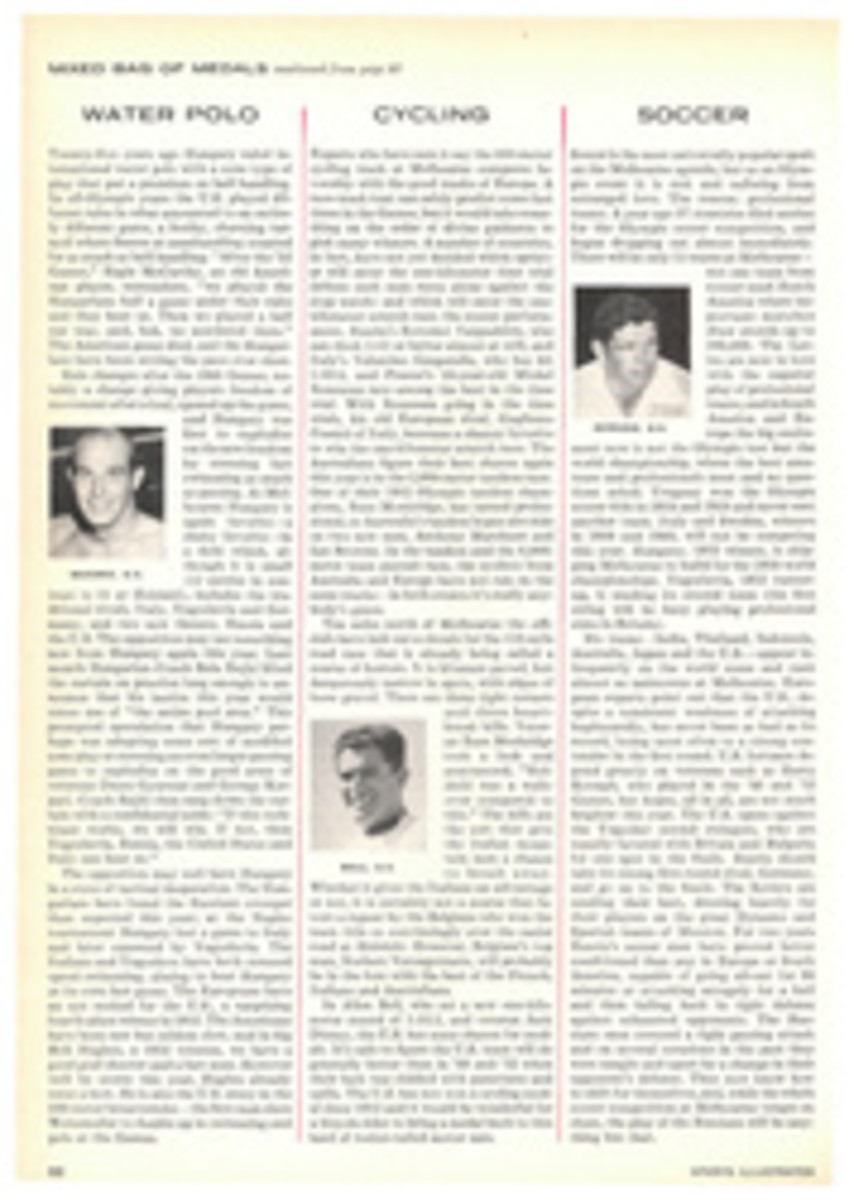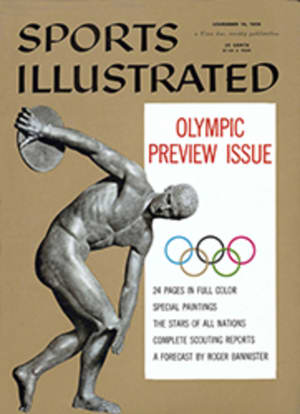
A DAY OF DECISION
Midway through the third quarter in Atlanta's Grant Field Saturday afternoon, Tennessee's Volunteers had possession of the ball on their own 38-yard line. There was still no score in the tense battle between the Vols' third-ranked single-wing powerhouse and Georgia Tech's second-ranked split-T Yellow Jackets.
Tennessee Fullback Tommy Bronson had just gained two yards off tackle, leaving second and eight to go. It was a routine play, but alert End Buddy Cruze had spotted something important. For the first time all day, Tech had dropped its double-teaming alignment against him. To Cruze, who had been completely bottled since the game began, the switch was like a tonic. Rushing to the huddle he tapped Johnny Majors, the signal caller, on the back.
"Hey, John," he whispered, "I think I can get off."
The tailback simply nodded.
There followed, in the space of 53 seconds, the only touchdown of the day.
After a successful short pass to Cruze on the right sideline, Majors called Tennessee's weak-side run-pass—the exact play diagramed with SPORTS ILLUSTRATED'S manikins last week. Cruze took the pass on Tech's 35 with Safety Man Wade Mitchell looming up a step ahead and Halfback Paul Rotenberry closing swiftly from the right. Cruze cut left, and Mitchell ran headlong into Rotenberry. Both went down as Cruze took off, to be hauled down on the one-yard line. Bronson hurdled the final yard, and Tennessee had enough to win its biggest victory of the year 6-0.
Aside from this opportunistic score, the game produced a nigh-perfect defensive struggle in which the kick held the starring role. There were 23 punts in all, and their beauty lay not so much in distance—or lack of it—as an uncanny sense of placement. Seldom has the kick been used more effectively to stifle the offense.
"Bobby Dodd and I both like to kick," called Bowden Wyatt from under a steaming shower in the Tennessee dressing room afterwards. "We knew we had to keep Tech bottled up deep or they'd run us ragged with those half-dozen good backs of theirs once they got operating room."
What operating room Tech got, they had to get themselves. Receiving Tennessee's 12 kicks, the Yellow Jackets were never able to commence operations farther out than their own 31-yard line. Five times they had to start inside their 10, four times inside their five. Majors quick-kicked 68 yards on first down to the Tech 17 in the first quarter. Bobby Gordon got off another for 60 yards from his own three in the second quarter. Majors dribbled one 43 yards that died on the Tech two-inch line just before the half ended. In the third quarter Majors booted 50 yards to the Tech seven, and Al Carter lofted one 40 to the Tech four. Meanwhile Tech's Kenny Owen and Johnny Menger had both rolled kicks to a stop inside Tennessee's five.
It was a whooping bunch of Volunteers who rushed back to the musty dressing room for their showers. Captain John Gordy, the rugged tackle, flung his helmet chin strap high in the air and crushed Back Bill Anderson in a bear hug.
"Hot damn," cried Gordy. "That one was solid gold, man."
And golden it may have been, for waiting by the dressing room door was Fred Digby, general manager of the Sugar Bowl. Pumping Coach Wyatt's hand a minute later, Digby gave hearty congratulations, turned to a reporter.
"We sure like this team," he enthused. "They'd make a great attraction for us."
Had Iowa used some special trick to make Minnesota fumble five times last Saturday? How had they set the stage for the mild upset which propelled the Hawkeyes into the forefront of the Rose Bowl battle? What ruse brought favored Minnesota its first setback of an otherwise pleasant fall?
The Gopher players weren't sure.
Bob Schultz, Minnesota's right halfback and favorite runner when the going gets tough, explained his own three fumbles—each recovered by the Hawkeyes—this way: "They seemed to get to us before we ever got the ball...."
Bobby Cox, the quarterback, had another idea: "They seemed to have all our plays covered."
On the very first play of this nationally televised game the Gophers incurred a clipping penalty. "I was afraid that was going to be indicative of a long afternoon," Coach Murray Warmath said later. How right he was.
A couple of minutes later Iowa's alert Frank Gilliam pounced on a Gopher fumble. Ken Ploen, the Iowa quarterback, next completed two of the four successful Iowa passes. Fullback Fred Arris plunged over from the one, and with only five minutes and four seconds of the game gone the scoring had ended.
Iowa was thereafter content to sit on its lead while Minnesota moved into Hawkeye territory six times without ever reaching the promised land. The Hawkeyes were opportunists with a sound defense, while the Gophers were the victims of their own mistakes. Although the Gophers had a wide edge in the statistics, the Hawkeyes had the edge where it counted.
OREGON STATE 20
STANFORD 19
Oregon state's football team is usually one of the forgotten members of the Pacific Coast Conference, yet when A. Thompson (Tommy) Prothro arrived there in 1955 he brashly promised a Rose Bowl team within three years. Asked if he knew where he was, Prothro said, "Sure, this is Oregon State. I played against Oregon State in the Rose Bowl of 1942, and we got beat. I respect this school."
Years later Tommy became an assistant to Red Sanders at UCLA, and this year's OSC attack is a carbon copy of the Sanders single wing. What Prothro has over Sanders this season are two slender blur-running halfbacks, Earnel Durden and Paul Lowe, who can take off right now. Both, incidentally, are from Los Angeles and part of a 42-man squad that includes 20 Californians. When the Beavers go to Pasadena on January 1—in Prothro's second year as head coach—it will be old home week.
Prothro planned his Stanford game hopefully. He put up an umbrella defense against John Brodie, Stanford's great quarterback, conserving his strength, and resting his first stringers as much as possible to save them for the last quarter. "We felt we'd be dead either way unless we saved something," he said in his low, southern drawl. "Either trying to score, or defending against passes, we wanted to be a little fresher than Stanford."
In the end, however, it was missed conversions that made the point difference.
TEXAS A&M 33
SOUTHERN METHODIST 7
Texas A&M, which won its early crucial games by coming through brilliantly in the clutch, has eliminated the clutch play and matured into a team which is overwhelming throughout the whole game. Saturday the Aggies ruined a good SMU club, which had lost to Georgia Tech by only 2 points, running up an easy 33-7 victory.
John Crow, the thunderous halfback, had another of his fine days, with two touchdowns and a 56-yard punt return. He shared top billing with Roddy Osborne, who has developed into a grim keeper at quarterback; Guard Dee Powell, playing out the season with a broken nose as if he wanted the opposition to share his misery; quick, tough Tackle Jim Stanley, who recovered two fumbles; reserve Fullback George Gillar, a bear cat on pass defense who broke through for a 44-yard scoring sprint; and, above all, a host of gang-tackling Aggies.
The Aggies were playing in the shadow of NCAA probation, and if the NCAA fails to clear the Aggies, the Southwest Conference-will be faced with the dreary prospect of either thrice-beaten Texas Christian or thrice-beaten Southern Methodist as its representative in the Cotton Bowl come New Year's Day—instead of unbeaten Texas A&M.
PHOTO
JOHN G. ZIMMERMAN
TENNESSEE 6 GEORGIA TECH 0
TENNESSEE BACK TOMMY BRONSON (31) SAILS OVER CLASHING LINES INTO TECH'S IMMOVABLE DON STEPHENSON (50)
PHOTO
EARL SEUBERT
IOWA 7 MINNESOTA 0
IOWA'S CENTER BOB CUMMINGS (50) CLEARS PATH AS FRED HARRIS BOOMS PAST BERNARD SVENDSEN (52) FOR WINNING SCORE
PHOTO
SPEED OF PAUL LOWE (47) HELPED OREGON STATE OVER STANFORD
PHOTO
COLORADO 14
MISSOURI 14
Colorado's Howard Cook (21) is pulled down by Missouri's Bill Craig after returning punt to the Colorado 25-yard line. Battling for a shot at the Orange Bowl. Missouri jumped to an early 14-0 lead and seemed victory-bound until a pair of untimely third-quarter fumbles changed the picture. The consequent tie practically insured the Buffs of a New Year's Day trip to Miami as Big Seven representative. Oklahoma is not eligible.
PHOTO
TEXAS AGGIES' JOHN CROW (44) GETS PERFECT BLOCKING ON HIS WAY TO A 15-YARD OFF-TACKLE SCORE AGAINST SOUTHERN METHODIST
PHOTO
MICHIGAN 17
ILLINOIS 7
Michigan's wing-footed Jimmy Pace soars to evade an Illinois tackier during a seven-yard run. Pace brought Wolverines from behind with second-period score to keep alive faint Michigan Rose Bowl hopes
THE ELEVEN BEST TO DATE
Georgia Tech
Iowa
Miami
Michigan State
Minnesota
Ohio State
Oklahoma
Oregon State
Syracuse
Tennessee
Texas A&M

